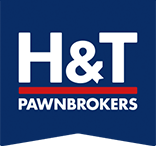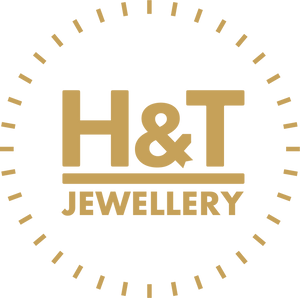Currencies of the world: A guide to different types of currency
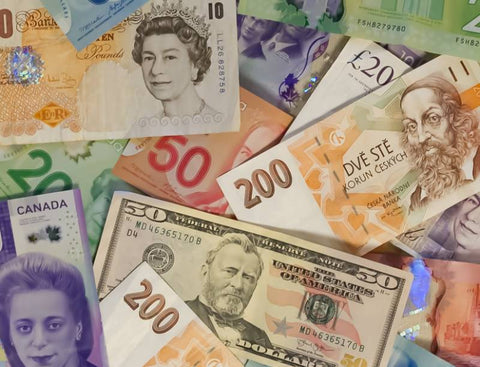
There are a staggering 180 different world currencies, so it’s no surprise that getting travel money can sometimes be an overwhelming process. The good news is that we offer a wide variety of different currencies available at competitive rates here at H&T. But before you get your travel money, it’s a good idea to know the basics of the currency you’ll be using, from the symbols used to what the cash looks like.
To help you find out more about all the different types of money, we’ve put together this handy world currencies list for some of the most requested currencies at H&T. Read on to find out all you need to know about the following:
- The US Dollar
- The Euro
- Bulgarian Lev
- Hungarian Forint
- Polish Zloty
- Thai Bhat
- Turkish Lira
The Euro

Name: Euro
Also known as: EUR
Symbol on the Euro: €
Denominations: €1 = 100 cents
Which countries use the Euro?
There are a wide range of European countries that use the Euro – in fact, it’s one of the most used world currencies! The Euro is the main currency type in the following countries:
- Andorra
- Austria
- Belgium
- Croatia
- Cyprus
- Estonia
- Finland
- France
- French Southern and Antarctic Lands
- Germany
- Greece
- Ireland
- Italy
- Latvia
- Lithuania
- Luxembourg
- Malta
- Monaco
- The Netherlands
- Portugal
- San Marino
- Saint Barthélemy
- Saint Pierre and Miquelon
- Slovakia
- Slovenia
- Spain
- Vatican City
This list of countries is made up of Eurozone members, EU special territories, and microstates (such as Vatican City) that have monetary agreements with Eurozone countries. There are also a number of countries with their own currency types that will be required to switch to the Euro at some point in the future as they are members of the EU. The Czech Republic, Hungary, Poland, and Sweden are all due to make the switch at some point but there is no date set in place. However, the Bulgarian Lev is expected to be replaced by January 1st 2025, and the Romanian Leu is expected to be replaced before 2029.
What do Euros look like?
The Euro currency comes in both coins and notes. Below are detailed descriptions of each denomination so you know exactly what the currency looks like before your next getaway.
Coins
Like many other currencies of the world, Euro coins don’t increase in size depending on value, with the exception of the €1 coin which is smaller than a 50 cents coin. While each coin has one common side which shows a map of Europe and the 12 European Union stars, they come with varying alternate sides. These are national sides which indicate the issuing country of the note. Below are descriptions of each coin and their common side.
|
Coin |
Size |
Description |
Colour |
|
1 cent |
16.25mm diameter |
Copper-coloured coin featuring a globe on the bottom right with 12 stars either side. To the left there is a large “1” and at the top right are the words “Euro cent”. |
Copper |
|
2 cents |
18.75mm diameter |
Copper-coloured coin featuring the same globe and stars design as the 1 cent coin. To the left there is a large “2” and at the top right are the words “Euro cent”. |
Copper |
|
5 cents |
21.25mm diameter |
Copper-coloured coin featuring the same globe and stars design as the 1 and 2 cent coin. To the left there is a large “5” and at the top right are the words “Euro cent”. |
Copper |
|
10 cents |
19.75mm diameter |
Gold-coloured coin featuring a map of Europe on the left half of the coin, with six stars at the edge of the top left, and six at the edge of the bottom left. To the top right there is a large “10”, with the words “Euro cent” underneath. |
Gold |
|
20 cents |
22.25mm diameter |
Gold-coloured coin featuring the same map and star design as the 10 cent coin on the left half. To the top right there is a large “20”, with the words “Euro cent” underneath. |
Gold |
|
50 cents |
24.25mm diameter |
Gold-coloured coin featuring the same map and star design as the 10 and 20 cent coin on the left half. To the top right there is a large “50”, with the words “Euro cent” underneath. |
Gold |
|
1 Euro |
23.25mm diameter |
This coin is silver on the inside with a gold ring around the outside. The right half of the coin features a map of Europe, with six stars at the edge of the top left, and six at the edge of the bottom left. The word “Euro” is written across the map, and on the left half there is a large “1”. |
Outer gold, inner silver |
|
2 Euro |
25.75mm diameter |
This coin is gold on the inside with a silver ring around the outside. The right half of the coin features a map of Europe, with six stars at the edge of the top left, and six at the edge of the bottom left. The word “Euro” is written across the map, and on the left half there is a large “2”. This is the only Euro coin which is allowed to be used for commemorative designs. |
Outer silver, inner gold |
Notes
Like Euro coins, Euro notes also increase in size depending on value. Each note features a unique European architectural style from different periods throughout history. The notes also come with watermarks located in the bottom left section of a note, which features the numeric value of the note and a portrait of Europa, a princess in Greek mythology. The €500 note features something slightly different however: the numeric value of the note and an image of a door/window. Below is a more detailed description of each note.
|
Note |
Colour |
Description |
|
5 Euro |
Grey |
This note depicts architecture from the Classical era. The front of the note features an archway, and the back features a bridge. |
|
10 Euro |
Red |
This note depicts the Romanesque era, with a archway on the front side and a bridge on the back side. |
|
20 Euro |
Blue |
This banknote features gothic style architecture, with windows on the front and a bridge on the back. |
|
50 Euro |
Orange |
This note depicts architecture from the Renaissance era, with windows on the front of the banknote and a bridge on the back. |
|
100 Euro |
Green |
The front of this note has an archway in Baroque style, and the back has an image of a bridge. |
|
200 Euro |
Yellow and brown |
The front of this banknote depicts Art Nouveau style windows, and on the back you’ll find an image of a bridge. |
|
500 Euro |
Purple |
This banknote features Modern architecture, with windows on the front of the note and a bridge on the back. |
The US Dollar
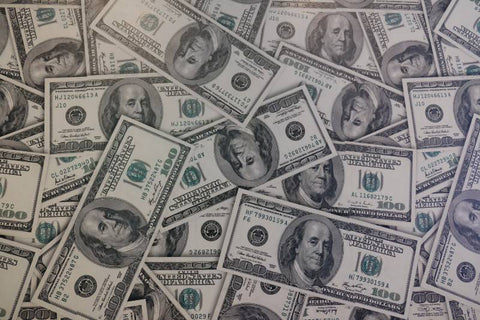
Name: American Dollar
Also known as: USD
Symbol on the American Dollar: $
Denominations: $1 = 100 cents
Which countries use the US dollar?
The American Dollar is accepted as money in different countries around the world, and is the main currency of:
- The USA
- Ecuador
- El Salvador
- East Timor
- Palau
- Micronesia
- The Marshall Islands
- The British Virgin Islands
- The Turks & Caicos Islands
- The Caribbean Netherlands
- Zimbabwe
- Panama
Many other countries will accept American Dollars alongside their own currency and in some cases it is the preferred method of payment: always do plenty of research on your destination before ordering your foreign currency and be sure the information you have is up to date.
What do Dollars look like?
The American Dollar comes in both coins and notes. Detailed descriptions of what these look like are listed below, so you can know exactly what you’re looking for.
Coins
US coins are relatively easy to identify and use, but are slightly less common than notes thanks to the existence and widespread usage of the $1 note. Be aware that the size of the coin does not always correspond with how much it is worth. The coins each have their own name, which can be confusing at first. These have been noted within brackets after each coin’s denomination below:
|
Coin |
Size |
Description |
Edge |
|
1 cent (Penny) |
19.05mm diameter |
Copper-coloured coin featuring Abraham Lincoln on one side and the Union Shield on the other, overlaid with a banner stating ‘ONE CENT’. |
Plain edged |
|
5 cents (Nickel) |
21mm diameter |
Silver-coloured coin with Thomas Jefferson on one side and Monticello (Jefferson’s plantation) on the other. |
Plain edged |
|
10 cents (Dime) |
17.91mm diameter |
Silver-coloured coin with Franklin D. Roosevelt on one side and an olive branch, a torch and an oak branch on the other. |
Scored edge |
|
25 cents (Quarter) |
24.26mm diameter |
Silver-coloured coin with George Washington on one side and one of many different designs on the other side (five different designs are released each year). |
Scored edge |
|
50 cents (Half) |
19.05mm diameter |
Silver-coloured coin with John F. Kennedy on one side and the presidential seal on the other. |
Scored edge |
|
1 Dollar |
26.50mm diameter |
Gold-coloured coin with Sacagawea and her child on one side and a variety of different designs on the other (a bald eagle in flight was used for $1 coins between 2000-2008, and there has been a new design each year ever since). |
Lettered edge |
Notes
Unlike many other currency types, American Dollar notes do not change in size dependent on their worth. To add to the confusion, they also all used to be the same colour (green). In recent years, most denominations have been redesigned with their own colour to make things a little easier. You may still come across green notes – particularly in separate countries who have adopted the dollar from the USA - which are still in circulation alongside the newer coloured versions. Each note has its denomination clearly printed in all four corners, which helps with identification, particularly if the notes are folded or stashed away in a money belt. All American Dollar notes have a plain border – the design does not come up to the edges of the paper.
|
Note |
Watermark |
Colour |
Description |
|
1 Dollar |
None |
Green |
Features George Washington on one side and what is known as the Great Seal of the United States on the other. |
|
2 Dollars |
None |
Green |
Features Thomas Jefferson on one side and an artist’s rendering of the signing of the Declaration of Independence on the other. |
|
5 Dollars |
Two number 5’s |
Purple |
Features Abraham Lincoln on one side and the Lincoln Memorial building on the other. |
|
10 Dollars |
Alexander Hamilton |
Orange |
Features Alexander Hamilton on one side and the US Treasury building on the other. |
|
20 Dollars |
Andrew Jackson |
Green |
Features Andrew Jackson on one side and the White House on the other. |
|
50 Dollars |
Ulysses S. Grant |
Pink |
Features Ulysses S. Grant on one side and the United States Capitol building on the other. |
|
100 Dollars |
Benjamin Franklin |
Light blue |
Features Benjamin Franklin on one side and Independence Hall on the other. |
Is it customary to barter and tip in the US?
Haggling or bartering is not overly common in the USA and is not deemed acceptable in general stores, supermarkets and restaurants. Much like the UK, there can be some bartering when it comes to flea markets, garage sales or when buying a more expensive item like a car or white goods, but the accepted custom can vary from state to state, so make sure you do plenty of research before you go.
Tipping is widespread in the USA and although it is technically optional, has an almost mandatory status in many establishments. If you do not tip when you should, or you have not tipped enough, it is likely that this will be mentioned to you. In many cases, bartenders and waitresses are paid very little per hour, and therefore tips are expected to make up the rest of their wages. This means tips are extremely important to them.
In restaurants it’s customary to tip 15-25% of the total bill, or even more for exemplary service. At bars, it’s expected that you add a dollar per drink if you’re sitting at the bar itself. For table service drinks, a 10% tip on top of the bill is expected. Taxi drivers and hairdressers will also expect a tip of around 20%, and bellhops at hotels will expect a tip for helping you with your bags; this is usually $1 per bag plus a few dollars.
The Bulgarian Lev
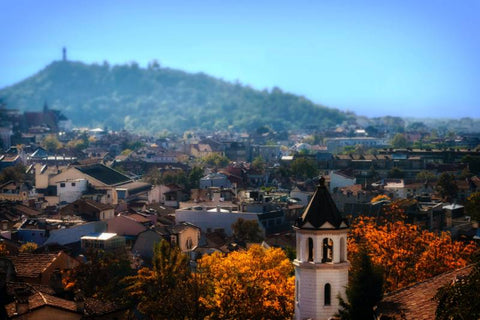
Name: Bulgarian Lev
Also known as: BGN
Symbol on the Bulgarian Lev: Лв
Denominations: Лв.1 = 100 stotinki
Where is the Bulgarian Lev used?
The Bulgarian Lev is only used in the country of Bulgaria. It’s important to note that as of 2025, Bulgaria will be switching to the Euro as it is now an EU country.
What does it look like?
The Bulgarian Lev comes in both coins and notes. Detailed descriptions of what these look like are listed below, so you know what to expect.
Coins
All Bulgarian coins are very easy to identify, making it one of the simpler world currencies to get to grips with. On one side of every stotinki coin, you’ll find the word ‘БЪΛΓΑΡИЯ’, which means ‘Bulgaria’ and the Madara Rider, which depicts a man on a horse. The Madara Rider is a large medieval rock carving which can be found in north-eastern Bulgaria and dates to the 700s AD.
|
Coin |
Size |
Description |
Edge |
|
1 Stotinka |
16mm diameter |
Copper-coloured coin with a ‘1’, the year it was minted, and CTOTИHKA (meaning ‘stotinka’) on one side, underneath a halo of 12 stars. |
Plain edged |
|
2 Stotinki |
18mm diameter |
Copper-coloured coin with a ‘2’, the year it was minted, and CTOTИHKИ (meaning ‘stotinki’) on one side, underneath a halo of 12 stars. |
Plain edged |
|
5 Stotinki |
20mm diameter |
Copper-coloured coin with a ‘5’, the year it was minted, and CTOTИHKИ (meaning ‘stotinki’) on one side, underneath a halo of 12 stars |
Plain edged |
|
10 Stotinki |
18mm diameter |
Silver-coloured coin with a ‘10’, the year it was minted, and CTOTИHKИ (meaning ‘stotinki’) on one side, underneath a halo of 12 stars. |
Scored edge |
|
20 Stotinki |
20.5mm diameter |
Silver-coloured coin with a ‘20’, the year it was minted, and CTOTИHKИ (meaning ‘stotinki’) on one side, underneath a halo of 12 stars.
|
Scored edge |
|
50 Stotinki |
22.5mm diameter |
Silver-coloured coin with a ‘50’, the year it was minted, and CTOTИHKИ (meaning ‘stotinki’) on one side, underneath a halo of 12 stars.
|
Scored edge |
|
1 Lev |
24.5mm diameter |
Bi-coloured coin (golden ring, silver centre) featuring a ‘1’, the year it was minted and a geometric pattern of two crossing lines on one side. On the other side, you’ll find an image of Saint Ivan Rilski – the first Bulgarian hermit. |
Alternate plain and scored edge |
|
2 Leva |
26.5mm diameter |
Bi-coloured coin (silver ring, golden centre) featuring a ‘2’, the year it was minted and a geometric pattern of two crossing lines on one side. On the other side, you’ll find an image of Saint Paisius of Hilendar – a key Bulgarian National Revival figure. |
Alternate plain and scored edge |
Notes
Bulgarian Lev banknotes go up in size the more they are worth, just like the banknotes we’re familiar with. There used to be a 1 Lev note in circulation, but this was replaced by the 1 Lev coin. If you happen to come across a 1 Lev note while you are in Bulgaria, you can still exchange these for the coin equivalent, but they will not be accepted in shops. Similarly, the 2 Leva coin is phasing out the use of the 2 Leva note and while they are still legal tender, they’re being used less and less. Look out for the all-important watermark on every banknote which proves authenticity.
|
Note |
Watermark |
Colour |
Description |
|
2 Leva |
Rampant lion |
Purple |
Features a portrait of Saint Paisius of Hilendar (who you’ll also find on the 2 Leva coin) on one side and his famous history book of Bulgaria, the ‘Istoriya Slavyanobolgarskaya’ is depicted on the other side. |
|
5 Leva |
Ivan Milev |
Red |
Features a portrait of Bulgarian artist Ivan Milev on one side, and a depiction of his paintings on the other side. |
|
10 Leva |
Petar Beron |
Yellow |
Features a portrait of Petar Beron, a Bulgarian educator on one side. On the other side, you’ll find astronomical instruments. |
|
20 Leva |
Stafan Stambolov |
Blue |
Features a portrait of Stefan Stambolov, former Prime Minister of Bulgaria, who was also a journalist, revolutionist and poet, on one side. Two of Bulgaria’s famous bridges, Eagle Eagles’ Bridge and Lion’s Bridge can be seen on the other side, as well as some of Stefan Stambolov’s poetry. |
|
50 Leva |
Pencho Slaveykov |
Brown |
Features a portrait of Pencho Slaveykov - a noted Bulgarian Poet - on one side and some of his poems, along with a large flying bird, on the other side |
|
100 Leva |
Aleko Konstantinov |
Turquois |
Features a portrait of Aleko Konstantinov, a Bulgarian writer, on one side. On the other side, you’ll find a more complete image of Konstantinov, along with his works and letters of the alphabet. |
Always check the watermark on your banknotes – the 20Лв note is the most frequently counterfeited as it is the most commonly used.
Is it customary to barter and tip in Bulgaria?
Haggling or bartering is not common in Bulgaria and the vast majority of shops will sell things at a fixed price. The exception to this is at furniture or antique markets, where you may be able to charm 10% – 25% off if you play your cards right.
Tipping is not a big thing in Bulgaria and you won’t be expected to tip everyone. In bars and restaurants, a tip of 10% for good service is normal. Hotel staff will not expect a tip at all unless you are staying at a high-end luxury hotel. When paying taxi drivers, it’s customary to round up to the nearest whole Lev. When tipping, particularly in restaurants, make sure you hand the tip to the person you want it to go to and always tip in cash, rather than via card.
Hungarian Forint
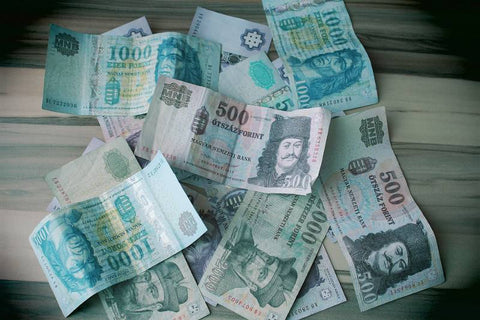
Name: Hungarian Forint
Also known as: HUF
Symbol on the Hungarian Forint: Ft
Denominations: Ft1 = 100 fillér (no longer used – see below)
Where is it used?
The Hungarian Forint is only used in Hungary.
What does it look like?
The Hungarian Forint only comes in note form: coins are no longer issued or used. This happened as recently as 1999, when the last fillér coins were withdrawn from circulation. However, the 1 and 2 Forint coins were used as legal tender up until 2008.
This is due to economic issues during the 1970’s, 80’s and 90’s which led to high inflation. It got to the point that 1 Hungarian Forint was worth so little (around half a US cent – $0.005), that the Fillér coins were worth barely anything. The coins ended up holding more value in their metal content, which meant they were worth more once melted down.
These days, the Hungarian Forint only exists in note form. Detailed descriptions of what these notes look like are listed below, so you know what to expect.
Notes
Hungarian Forint banknotes are different to the ones used in many other types of world currencies, in the fact that they are all the same size and do not get bigger as their value increases. This can mean that it’s a bit tricky to work out what you’ve got initially, but once you’re familiar with the colours of the notes then it should get a bit easier. Each note features a holographic strip down one side, as well as a watermark to prevent forgery. Although fake notes are rare, it’s wise to keep an eye out for 2,000 Forint notes which have had their ink partially dissolved, and then turned into a 20,000 Forint note – this is a known forgery which can be hard to spot, as both notes are of a similar colour.
|
Note |
Colour |
Description |
|
500 Forint |
Red |
Features a portrait of prince sovereign Frances II Rákóczi (who was the leader of the Hungarian uprising in the early 1700s) on one side and the Castle of Sárospatak is depicted on the other side. |
|
1,000 Forint |
Blue |
Features a portrait of King Matthias Corvinus (who was the King of both Hungary and Croatia during the 1400s) on one side and the Hercules Fountain from the Castle of Visegrád is depicted on the other side. |
|
2,000 Forint |
Brown |
Features a portrait of prince sovereign Gabriel Bethlen (who was King-elect of Hungary in 1620) on one side, and a painting of Bethlen ‘among his scientists’ by Viktor Madarász is depicted on the other. |
|
5,000 Forint |
Yellow |
Features a portrait of count István Széchenyi, a politician who is considered one of the greatest statesmen in Hungarian history on one side, and his mansion (the Széchenyi Mansion in Nagycenk) is depicted on the other side. |
|
10,000 Forint |
Purple |
Features a portrait of King Stephen I (who was the first King of Hungary from the year 1000 – 1038) on one side, and a view of the old city of Estergom on the other. |
|
20,000 Forint |
Green and orange |
Features a portrait of Ferenc Deák, who was a Hungarian statesman known as ‘The Wise Man of the Nation’ on one side, and the old House of Representatives on the other side. |
Is it customary to barter and tip in Hungary?
Haggling or bartering is not common in Hungary and the vast majority of shops will sell things at a fixed price. The exception to this is at markets, where you may be able to negotiate a lower price if you are buying many things at once. It’s worth remembering that Hungary is much like the UK with respect to haggling.
Tipping is expected throughout Hungary in bars, restaurants and when using a taxi. A tip of between 10% and 15% for good service is normal and expected. When tipping — particularly in restaurants — make sure you hand the tip directly to the person you want it to go to. Never leave cash on the table after a meal as this is considered rude. It’s also customary to state how much change you’d like back (if paying in cash) rather than splitting the amount once you get it back.
Polish Zloty

Name: Polish Zloty
Also known as: PLN
Polish Zloty symbol: zł
Denominations: zł 1 = 100 groszy
Where is the Polish Zloty used?
The Polish Zloty is only used in Poland.
What does it look like?
Polish Zloty comes in both coins and notes. The words ‘Zloty’ and ‘Grosz’ change slightly depending on how many you’re talking about — all the correct terms are listed below.
Coins
All Polish coins feature the Polish eagle coat of arms and the name of a Polish state on one side.
|
Coin |
Size |
Description |
Edge |
|
1 Grosz |
15.5mm diameter |
Copper-coloured coin with ‘1’ and a leaf featured on it. |
Scored edge |
|
2 Grosze |
17.5mm diameter |
Bronze-coloured coin with ‘2’ and two leaves depicted on it. |
Plain edged |
|
5 Groszy |
19.5mm diameter |
Bronze-coloured coin with a ‘5’ and five leaves featured on the design. |
Alternate plain and scored edge |
|
10 Groszy |
16.5mm diameter |
Silver-coloured coin with a ‘10’, surrounded by a ring of leaves. |
Alternate plain and scored edge |
|
20 Groszy |
18.5mm diameter |
Silver-coloured coin with a ‘20’, framed with square-shaped leaves. |
Scored edge |
|
50 Groszy |
20.5mm diameter |
Silver-coloured coin featuring a ‘50’ within a crescent of leaves. |
Scored edge |
|
1 Zloty |
23mm diameter |
Silver-coloured coin featuring a ‘1’ with a full circle of one hundred leaves. |
Alternate plain and scored edge |
|
2 Zloty |
21.5mm diameter |
Bi-coloured coin (golden ring, silver centre) featuring a ‘2’ with two leaves in the ring portion. |
Plain edged |
|
5 Zloty |
24mm diameter |
Bi-coloured coin (silver ring, golden centre) featuring a ‘5’ with 5 leaves in the ring portion. |
Irregular, rough edge |
Notes
Like many other currency types, Polish Zloty banknotes go up in size the more they are worth, just like the banknotes we know. Here we will talk through the most recent and most used series of Zloty notes, but there are other designs that you may come across when you are in Poland. Each note design from the 2012 series features a former ‘Sovereign of Poland’ on one side, along with a special embossed shape in the bottom left-hand corner so that blind and partially-sighted people can identify notes more easily.
|
Note |
Colour |
Embossed Shape |
Description |
|
10 Zlotych |
Dark brown |
Square |
Features a portrait of Mieszko I (who ruled Poland from 960AD) on one side and an old silver denar coin from Mieszko’s reign on the other. |
|
20 Zlotych |
Pink and purple |
Circle |
Features a portrait of Boleslaw I Chrobry (also known as Boleslaw the Brave), who ruled as King of Poland from 1025 on one side. A silver denar coin from the reign of Boleslaw can be seen on the other side. |
|
50 Zlotych |
Dark blue |
Diamond |
Features a portrait of Kazimierz III Wielki, the King of Poland from 1333 – 1370, on one side. On the other side, you’ll find a white eagle, a sceptre and an orb with a cross. |
|
100 Zlotych |
Dark green |
Cross shape |
Features a portrait of Wladyslaw II Jagiello, the King of Poland from 1386 – 1434, on one side. A shield with a white eagle, two swords and the coat of arms of the Teutonic Knights can be seen on the other side. |
|
200 Zlotych |
Brown and orange |
Triangle |
Features a portrait of Zygmunt I Stary, King of Poland from 1506 – 1548 on one side and an eagle intertwined with the letter ‘S’ on the other side. This is the only Polish note with a hologram included. |
|
500 Zlotych |
Violet, grey, blue, yellow and green |
Two vertical dotted lines |
Features a portrait of Jan III Sobieski, who was the King of Poland from 1674 until his death, on one side. On the other side, you’ll find an image of Wilanow Palace and the coat of arms from the reign of Sobieski. |
Is it customary to barter and tip?
Haggling or bartering is not the ‘done thing’ in Polish shops but is quite common when shopping in markets and bazaars. However, there are a few things worth remembering:
- Never be the first to suggest a price.
- Haggle with humour – it is appreciated in Poland!
- If you are buying a few items from the same place, asking for a discount or an extra freebie is acceptable.
It was once customary to tip for almost everything in Poland, but these days it’s more about rewarding good service. In general, tipping in Poland should be treated in much the same way as tipping in the UK. If you receive bad service, it is acceptable not to tip at all. Catering and waiting staff will expect a tip for a job well done, as their wages are usually very low, so part of their income comes from tips. Adding 10% or more to your bill is customary — try to pay your waiter or waitress directly in cash so that they definitely receive your tip. Tipping your taxi driver is not a must, but it’s common to round up the fare for ease of payment, and the taxi driver is likely to be very appreciative.
Thai Bhat
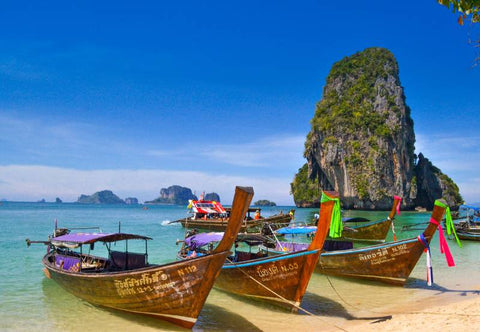
Name: Thai Baht
Also known as: THB
Bhat currency symbol: ฿
Denominations: ฿1 = 100 Satang
Where is it used?
The Thai Baht is only used in Thailand.
What does it look like?
The Thai Baht comes in both coins and notes. Detailed descriptions of what these look like are listed below, so you know what to look out for.
Coins
Thai coins can be rather confusing, partly because there is more than one design in circulation for each denomination. The previous king of Thailand, Bhumibol Adulyadej, features on older coins. King Bhumibol Adulyadej died in 2016 and has been succeeded by his son, King Maha Vajiralongkorn, who features on the newer coins.
|
Coin |
Size |
Description |
Edge |
|
25 Satang: Version 1 |
16mm diameter |
Gold-coloured coin with King Bhumibol Adulyadej on one side and Wat Phra Mahathat temple on the other. |
Plain edged |
|
25 Satang: Version 2 |
16mm diameter |
Copper-coloured coin with King Bhumibol Adulyadej on one side and Wat Phra Mahathat temple on the other. |
Plain edged |
|
25 Satang: Version 3 |
16mm diameter |
Copper-coloured coin with King Maha Vajiralongkorn on one side and his monogram on the other. |
Plain edged |
|
50 Satang: Version 1 |
18mm diameter |
Gold-coloured coin with King Bhumibol Adulyadej on one side and Wat Phrathat Doi Suthep temple on the other. |
Plain edged |
|
50 Satang: Version 2 |
18mm diameter |
Copper-coloured coin with King Bhumibol Adulyadej on one side and Wat Phrathat Doi Suthep temple on the other. |
Plain edged |
|
50 Satang: Version 3 |
18mm diameter |
Copper-coloured coin with King Maha Vajiralongkorn on one side and his monogram on the other. |
Plain edged |
|
1 Bhat: Version 1 |
20mm diameter |
Silver-coloured coin with King Bhumibol Adulyadej on one side and Wat Phra Kaew temple on the other. |
Plain edged |
|
1 Bhat: Version 2 |
20mm diameter |
Exactly the same look and features as above, except this coin is slightly lighter due to it being made with low-carbon steel. |
Plain edged |
|
1 Bhat: Version 3 |
20mm diameter |
Silver-coloured coin with King Maha Vajiralongkorn on one side and his monogram on the other. |
Plain edged |
|
2 Baht: Version 1 |
21.75mm diameter |
Silver-coloured coin with King Bhumibol Adulyadej on one side and Wat Saket temple on the other. |
Plain edged |
|
2 Baht: Version 2 |
21.75mm diameter |
Gold-coloured coin with King Bhumibol Adulyadej on one side and Wat Saket temple on the other. |
Plain edged |
|
2 Baht: Version 3 |
21.75mm diameter |
Gold-coloured coin with King Maha Vajiralongkorn on one side and his monogram on the other. |
Plain edged |
|
5 Baht: Version 1 |
24mm diameter |
Silver-coloured coin with King Bhumibol Adulyadej on one side and Wat Benchamabophit temple on the other. |
Plain edged |
|
5 Baht: Version 2 |
24mm diameter |
Exactly the same look and features as above, except this coin is slightly lighter. |
Plain edged |
|
5 Baht: Version 3 |
24mm diameter |
Silver-coloured coin with King Maha Vajiralongkorn on one side and his monogram on the other. |
Plain edged |
|
10 Baht: Version 1 |
24mm diameter |
Bi-coloured coin (gold coloured centre and a silver coloured outer ring) with King Bhumibol Adulyadej on one side and Wat Arun temple on the other. |
Plain edged |
|
10 Baht: Version 2 |
24mm diameter |
Bi-coloured coin (gold coloured centre and a silver coloured outer ring) with King Maha Vajiralongkorn on one side and his monogram on the other. |
Plain edged |
Coins worth 1 Satang, 5 Satang, and 10 Satang do exist, but are not in general circulation. Instead, they are used internally between banks. You are unlikely to come across any of these coins whilst there.
Notes
Thai Baht banknotes go up in size the more they are worth, which is a handy feature in notes you’re unfamiliar with. However, only the width of the notes changes; the height stays the same. As with Thai coins, there is more than one version of each note in circulation, owing to the relatively recent change of monarch. Thankfully however, the colours used for each denomination remain the same, no matter which version you have.
|
Note |
Colour |
Description |
|
20 Baht: Version 1 |
Green |
Features King Bhumibol Adulyadej in military uniform on one side, and King Ananda Mahidol on the other. |
|
20 Baht: Version 2 |
Green |
Features King Bhumibol Adulyadej in the Royal House of Chakri gown on one side, and King Ram Khamhaeng the Great on the other. |
|
20 Baht: Version 3 |
Green |
Features King Maha Vajiralongkorn in military uniform on one side, and Kings Buddha Yodfa Chulaloke and Buddha Loetla Nabhalai on the other. |
|
50 Baht: Version 1 |
Blue |
Features King Bhumibol Adulyadej in military uniform on one side, and King Mongkut on the other. |
|
50 Baht: Version 2 |
Blue |
Features King Bhumibol Adulyadej in the Royal House of Chakri gown on one side, and King Naresuan the Great on the other. |
|
50 Baht: Version 3 |
Blue |
Features King Maha Vajiralongkorn in military uniform on one side, and Kings Nangklao and Mongkut on the other. |
|
100 Baht: Version 1 |
Red |
Features King Bhumibol Adulyadej in military uniform on one side, and Kings Chulalongkorn and Vajiravudh on the other. |
|
100 Baht: Version 2 |
Red |
Features King Bhumibol Adulyadej in the Royal House of Chakri gown on one side, and King Taksin the Great on the other. |
|
100 Baht: Version 3 |
Red |
Features King Maha Vajiralongkorn in military uniform on one side, and Kings Chulalongkorn and Vajiravudh on the other. |
|
500 Baht: Version 1 |
Purple |
Features King Bhumibol Adulyadej in military uniform on one side, and King Nangklao on the other. |
|
500 Baht: Version 2 |
Purple |
Features King Bhumibol Adulyadej in the Royal House of Chakri gown on one side, and King Buddha Yodfa Chulaloke the Great on the other. |
|
500 Baht: Version 3 |
Purple |
Features King Maha Vajiralongkorn in military uniform on one side, and Kings Prajadhipok and Ananda Mahidol on the other. |
|
1000 Baht: Version 1 |
Brown |
Features King Bhumibol Adulyadej in military uniform on one side, and another image of him on the other side, along with an image of Pa Sak Jolasid Dam. |
|
1000 Baht: Version 2 |
Brown |
Features King Bhumibol Adulyadej in the Royal House of Chakri gown on one side, and King Chulalongkorn the Great on the other. |
|
1000 Baht: Version 3 |
Brown |
Features King Maha Vajiralongkorn in military uniform on one side, and Kings Bhumibol Adulyadej and Maha Vajiralongkorn on the other. |
The Thai people have a great love for the late King Bhumibol and due to this its important to handle money very respectfully. Dropping money on the floor is considered rude and even stepping on a banknote to stop it from flying away would not be deemed acceptable behaviour.
Is it customary to barter and tip in Thailand?
Haggling or bartering is common in Thailand and you will be expected to negotiate on prices, unless you’re happy to pay over the odds for something. It’s likely you’ll be handed a calculator by the vendor with the price on it, which you’ll then type your offer into: ask for 50%-70% off initially, and expect the calculator to get passed back and forth a few times before you reach an agreement.
Haggling in Thailand is usually an upbeat situation and so laughing and joking with the vendor is often encouraged. It’s considered very embarrassing if someone gets angry or aggressive over bartering for goods, so keep it light.
Unlike haggling, tipping is not customary or widespread in Thailand and it will never be expected of you to leave a tip. In cases where you have received good service however, a small tip is likely to be very much appreciated. If you have had a good taxi journey, rounding up the fare is customary, particularly if the driver has helped you with any luggage.
Turkish Lira
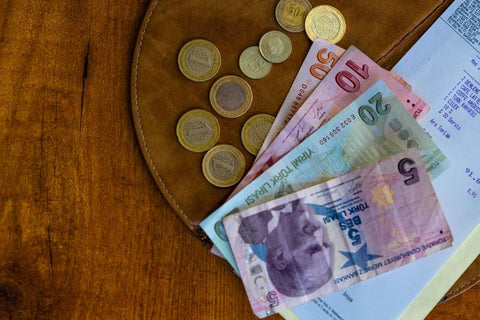
Name: Turkish Lira
Also known as: TRY
Turkish Lira symbol: ₺
Denominations: ₺1 = 100 Kuruş
Where is the Turkish Lira used?
The Turkish Lira is used in Turkey, as well as in the self-declared Turkish Republic of Northern Cyprus.
What does it look like?
Turkish Lira comes in both coins and notes.
Coins
All Turkish coins feature the head of Mustafa Kemal Atatürk, the first President of Turkey on one side.
|
Coin |
Size |
Description |
Edge |
|
1 Kuruş |
16.5mm diameter |
Copper-coloured coin with a ‘1’ and a snowdrop flower featured on it. |
Plain edged |
|
5 Kuruş |
17.5mm diameter |
Bronze-coloured coin with a ‘5’ and the tree of life depicted on it. |
Plain edged |
|
10 Kuruş |
18.5mm diameter |
Bronze-coloured coin with a ‘10’, surrounded by a Rumi design. |
Plain edged |
|
25 Kuruş |
20.5mm diameter |
Bronze-coloured coin with a ‘25’, surrounded by Kufic Arabic script. |
Scored edge |
|
50 Kuruş |
23.85mm diameter |
Bi-coloured coin (silver ring, golden centre) with a ‘50’ over an image of the Bosphorus Bridge and a silhouette of Istanbul. |
Wide-scored edge |
|
1 Lira |
26.15mm diameter |
Bi-coloured coin (golden ring, silver centre) featuring a ‘1’ over a Rumi design. |
Inscribed edge |
Notes
Turkish Lira banknotes go up in size the more they are worth, just like in many other types of currency. As with the coins, each banknote features Mustafa Kemal Atatürk on one side.
|
Note |
Colour |
Description |
|
5 Lire |
Brown or purple |
Features Aydın Sayılı (a Turkish historian of science), as well as the solar system, an atom, and a DNA helix. |
|
10 Lira |
Red |
Features Cahit Arf (a Turkish mathematician) as well as Arf’s equations, the binary sequence, and an abacus. |
|
20 Lira |
Green |
These notes feature Ahmet Kemaleddin (a Turkish architect) as well as an aqueduct, Gazi University main building, and a cube-globe-cylinder motif. |
|
50 Lira |
Orange |
Features Fatma Aliye (a Turkish novelist and women’s rights activist) as well as flowers, books, and writing materials. |
|
100 Lira |
Blue |
These notes feature Mustafa Itri (a Turkish musician, singer and poet) as well as musical notes, instruments, and a symbol of the Mevlevi Order. |
|
200 Lira |
Violet |
These notes feature Yunus Emre (a Turkish poet and Sufi mystic) a rose, his mausoleum, a pigeon, and the line ‘Sevelim sevilelim’, which means, ‘Let us love, let us be loved’. |
Is it customary to barter and tip in Turkey?
Haggling or bartering is a widespread tradition in Turkey, and you will be expected to negotiate the price in many shops. It is even customary to barter the cost of your hotel room, should you wish to pay less. However make sure to bear the following in mind before you do so:
- Never be the first to suggest a price.
- Try not to show too much interest in what you want.
- Even if you have been haggling for ages, don’t feel pressured to buy.
- Always pay cash, as you may be charged extra for card transactions.
It is customary to tip between 5% and 10% in Turkey as a general rule, but more can be given for exemplary service. If you receive bad service, then it is acceptable not to tip at all. Hotel staff and waiting staff will expect a tip for a good job done. Tipping your taxi driver is not a must, but it’s common practice to round up the fare.
If you’re planning a getaway and want to find out all about the cash you need, hopefully this guide to currencies of the world has been helpful for you. Looking for travel money for your next trip? Here at H&T you’ll find great rates with our currency exchange service, and we offer a handy buyback service too. Pop in to your local branch to find out more about the different currencies we have to choose from.
And if you’re looking for more travel advice and inspiration, make sure to check out our blog posts for 5 of the best alternative winter breaks, Insta-worthy holiday destinations, and more.

